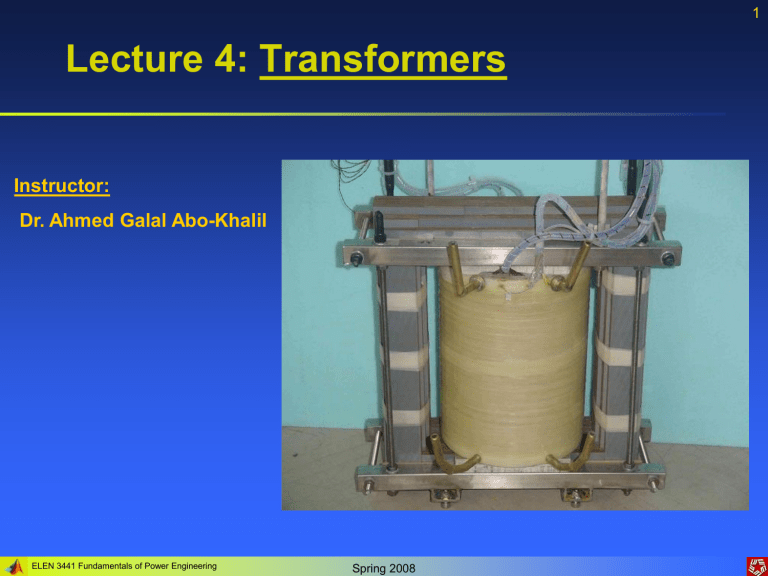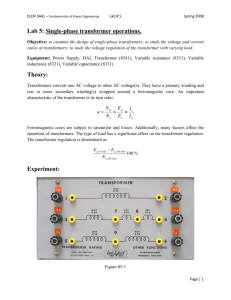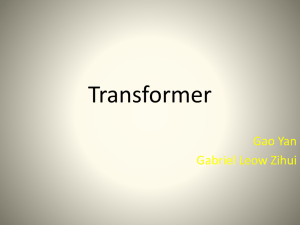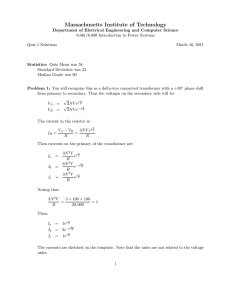Transformer 1

Lecture 4: Transformers
Instructor:
Dr. Ahmed Galal Abo-Khalil
1
ELEN 3441 Fundamentals of Power Engineering Spring 2008
Some history
Historically, the first electrical power distribution system developed by Edison in
1880s was transmitting DC . It was designed for low voltages (safety and difficulties in voltage conversion); therefore, high currents were needed to be generated and transmitted to deliver necessary power. This system suffered significant energy losses !
The second generation of power distribution systems (what we are still using) was proposed by Tesla few years later. His idea was to generate AC power of any convenient voltage, step up the voltage for transmission (higher voltage implies lower current and, thus, lower losses), transmit AC power with small losses, and finally step down its voltage for consumption. Since power loss is proportional to the square of the current transmitted, raising the voltage, say, by the factor of 10 would decrease the current by the same factor (to deliver the same amount of energy) and, therefore, reduce losses by factor of 100.
The step up and step down voltage conversion was based on the use of transformers .
ELEN 3441 Fundamentals of Power Engineering Spring 2008
2
Preliminary considerations
A transformer is a device that converts one AC voltage to another AC voltage at the same frequency. It consists of one or more coil(s) of wire wrapped around a common ferromagnetic core. These coils are usually not connected electrically together. However, they are connected through the common magnetic flux confined to the core.
Assuming that the transformer has at least two windings, one of them
( primary ) is connected to a source of
AC power; the other ( secondary ) is connected to the loads.
The invention of a transformer can be attributed to Faraday, who in 1831 used its principle to demonstrate electromagnetic induction foreseen no practical applications of his demonstration.
Russian engineer Yablochkov in 1876 invented a lighting system based on a set of induction coils, which acted as a transformer.
ELEN 3441 Fundamentals of Power Engineering Spring 2008
3
More history
Gaulard and Gibbs first exhibited a device with an open iron core called a
'secondary generator' in London in 1882 and then sold the idea to a company
Westinghouse. They also exhibited their invention in Turin in 1884, where it was adopted for an electric lighting system.
In 1885, William Stanley, an engineer for Westinghouse, built the first commercial transformer after George Westinghouse had bought Gaulard and
Gibbs' patents. The core was made from interlocking E-shaped iron plates. This design was first used commercially in 1886.
Hungarian engineers Zipernowsky, Bláthy and Déri created the efficient "ZBD" closed-core model in 1885 based on the design by Gaulard and Gibbs. Their patent application made the first use of the word "transformer".
Another Russian engineer Dolivo-Dobrovolsky developed the first three-phase transformer in 1889.
Finally, in 1891 Nikola Tesla invented the Tesla coil, an air-cored, dual-tuned resonant transformer for generating very high voltages at high frequency.
ELEN 3441 Fundamentals of Power Engineering Spring 2008
4
Types and construction
Core form
Power transformers
Shell form
5
Windings are wrapped around two sides of a laminated square core.
Windings are wrapped around the center leg of a laminated core.
Usually, windings are wrapped on top of each other to decrease flux leakage and, therefore, increase efficiency.
ELEN 3441 Fundamentals of Power Engineering Spring 2008
Types and construction
Lamination types
Laminated steel cores Toroidal steel cores
Efficiency of transformers with toroidal cores is usually higher.
ELEN 3441 Fundamentals of Power Engineering Spring 2008
6
Types and construction
Power transformers used in power distribution systems are sometimes referred as follows:
A power transformer connected to the output of a generator and used to step its voltage up to the transmission level (110 kV and higher) is called a unit transformer .
A transformer used at a substation to step the voltage from the transmission level down to the distribution level (2.3 … 34.5 kV) is called a substation transformer .
A transformer converting the distribution voltage down to the final level (110 V,
220 V, etc.) is called a distribution transformer .
In addition to power transformers, other types of transformers are used.
7
ELEN 3441 Fundamentals of Power Engineering Spring 2008
Ideal transformer
We consider a lossless transformer with an input (primary) winding having N p turns and a secondary winding of N s turns.
The relationship between the voltage applied to the primary winding v p
( t ) and the voltage produced on the secondary winding v s
( t ) is s p
( )
N p
( ) N s a
Here a is the turn ratio of the transformer.
ELEN 3441 Fundamentals of Power Engineering Spring 2008
(4.8.1)
8
Ideal transformer
The relationship between the primary i p
( t ) and secondary i s
( t ) currents is s p
( )
1
( ) a
(4.9.1)
In the phasor notation:
V p a
V s
I p
I s
1 a
(4.9.2)
(4.9.3)
The phase angles of primary and secondary voltages are the same. The phase angles of primary and secondary currents are the same also. The ideal transformer changes magnitudes of voltages and currents but not their angles.
ELEN 3441 Fundamentals of Power Engineering Spring 2008
9
Ideal transformer
One winding’s terminal is usually marked by a dot used to determine the polarity of voltages and currents.
If the voltage is positive at the dotted end of the primary winding at some moment of time, the voltage at the dotted end of the secondary winding will also be positive at the same time instance.
If the primary current flows into the dotted end of the primary winding, the secondary current will flow out of the dotted end of the secondary winding.
10
ELEN 3441 Fundamentals of Power Engineering Spring 2008
Power in an ideal transformer
Assuming that
p and
s are the angles between voltages and currents on the primary and secondary windings respectively, the power supplied to the transformer by the primary circuit is:
P in
V I p p cos
p
(4.11.1)
The power supplied to the output circuits is
P out
V I s s cos
s
(4.11.2)
Since ideal transformers do not affect angles between voltages and currents:
p
s
(4.11.3)
Both windings of an ideal transformer have the same power factor.
11
ELEN 3441 Fundamentals of Power Engineering Spring 2008
Power in an ideal transformer
Since for an ideal transformer the following holds:
V s
V a p
; I s aI p
(4.12.1)
Therefore:
P out
V I s s cos
V p a aI p cos
V I p p cos
P i n
The output power of an ideal transformer equals to its input power – to be expected since assumed no loss. Similarly, for reactive and apparent powers:
(4.12.2)
Q out
V I s s sin
V I p p sin
Q in
(4.12.3)
S out
V I s s
V I p p
S in
(4.12.4)
ELEN 3441 Fundamentals of Power Engineering Spring 2008
12
Impedance transformation
The impedance is defined as a following ratio of phasors:
Z
V I
L L L
A transformer changes voltages and currents and, therefore, an apparent impedance of the load that is given by
Z
V I
L s s
(4.13.2)
The apparent impedance of the primary circuit is:
Z '
V I
L p p
(4.13.3)
(4.13.1) which is
Z
L
'
V p p
I I a s
V s a
a
2
V s
I s
L
(4.13.4)
It is possible to match magnitudes of impedances (load and a transmission line) by selecting a transformer with the proper turn ratio.
ELEN 3441 Fundamentals of Power Engineering Spring 2008
13
Analysis of circuits containing ideal transformers
A simple method to analyze a circuit containing an ideal transformer is by replacing the portion of the circuit on one side of the transformer by an equivalent circuit with the same terminal characteristics.
Next, we exclude the transformer from the circuit and solve it for voltages and currents.
The solutions obtained for the portion of the circuit that was not replaced will be the correct values of voltages and currents of the original circuit.
Finally, the voltages and currents on the other side of the transformer (in the original circuit) can be found by considering the transformer’s turn ratio.
This process is called referring of transformer’s sides.
14
ELEN 3441 Fundamentals of Power Engineering Spring 2008
Analysis of circuits containing ideal transformers: Example
Example 4.1
: A single-phase power system consists of a 480-V 60-Hz generator that is connected to the load Z load
Z line
= 4 + j3
through the transmission line with
= 0.18 + j0.24
. a) What is the voltage at the load? What are the transmission line losses? b) If a 1:10 step up transformer and a 10:1 step down transformer are placed at the generator and the load ends of the transmission line respectively, what are the new load voltage and the new transmission line losses?
a) Here:
I
G
I line
I load
V
Z Z line
load
0.18
j 0
j 3
.8
90.8
37 .8
A
15
ELEN 3441 Fundamentals of Power Engineering Spring 2008
Analysis of circuits containing ideal transformers: Example
Therefore, the load voltage:
V load
I Z load load
90.8
j 3)
90.8
37.8
454
0.9
V
The line losses are:
2
P I R loss line line
2
W b) We will
1) eliminate transformer T
2 by referring the load over to the transmission line’s voltage level.
2) Eliminate transformer T
1 by referring the transmission line’s elements and the equivalent load at the transmission line’s voltage over to the source side.
ELEN 3441 Fundamentals of Power Engineering Spring 2008
16
Analysis of circuits containing ideal transformers: Example
The load impedance when referred to the transmission line (while the transformer T
2 is eliminated) is:
'
Z load
a
2
2
Z load
10
1
2
4
j 3
400
j 300
The total impedance on the transmission line level is
Z eq
Z line
Z
' load
400.18
j 300.24
500.3 36.88
The total impedance is now referred across T
1
Z
' eq
a
1
2
Z eq
1
10
2
500.3 36.88
to the source’s voltage level:
ELEN 3441 Fundamentals of Power Engineering Spring 2008
17
Analysis of circuits containing ideal transformers: Example
The generator’s current is
I
G
V
'
Z eq
5.003 36.88
95.94
36.88
A
Knowing transformers’ turn ratios, we can determine line and load currents:
I line
I load
a
1
I
G a
2
I line
36.88
9.594
36.88
A
36.88
95.94
36.88
A
Therefore, the load voltage is:
V load
I Z load load
95.94
36.88
5
36.87
479.7
0.01
V
The losses in the line are:
2
P I R loss line line
2
W
Note: transmission line losses are reduced by a factor nearly 90, the load voltage is much closer to the generator’s voltage – effects of increasing the line’s voltage.
ELEN 3441 Fundamentals of Power Engineering Spring 2008
18





